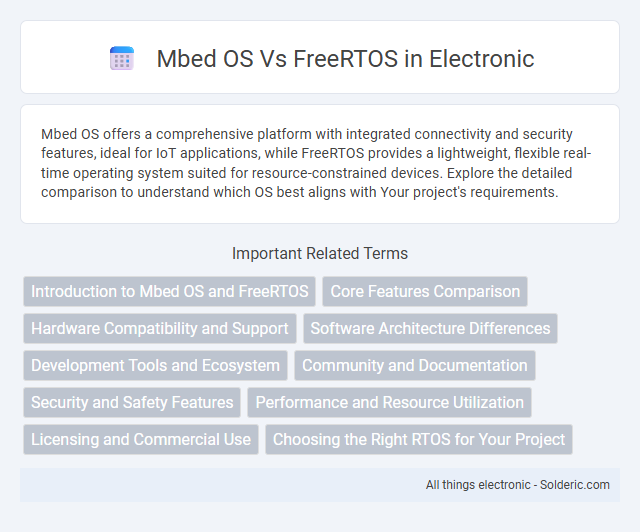Mbed OS offers a comprehensive platform with integrated connectivity and security features, ideal for IoT applications, while FreeRTOS provides a lightweight, flexible real-time operating system suited for resource-constrained devices. Explore the detailed comparison to understand which OS best aligns with Your project's requirements.
Comparison Table
| Feature | Mbed OS | FreeRTOS |
|---|---|---|
| Developer | Arm | Amazon Web Services (AWS) |
| License | Apache 2.0 | MIT License |
| Target Devices | Arm Cortex-M microcontrollers | Wide range of microcontrollers |
| RTOS Kernel | Built-in RTX5 kernel | Preemptive, priority-based kernel |
| Middleware & Libraries | Extensive networking, security, storage libraries | Minimal middleware, focused on kernel |
| Connectivity | Supports Bluetooth, LoRa, WiFi, Ethernet | Add-on stacks required |
| Development Tools | Mbed CLI, online compiler, Eclipse IDE support | Supports multiple IDEs, command-line tools |
| Community & Support | Arm backed with active developer community | Large, open source community & AWS support |
| Use Cases | IoT devices, embedded applications needing networking | Real-time control, embedded systems |
Introduction to Mbed OS and FreeRTOS
Mbed OS is an open-source, ARM-developed operating system designed for IoT devices, emphasizing ease of use, security, and connectivity. FreeRTOS, maintained by Amazon Web Services, is a lightweight, real-time operating system optimized for microcontrollers, widely used in embedded applications requiring deterministic behavior. Both OS platforms support diverse hardware architectures and offer extensive middleware, but Mbed OS integrates higher-level IoT protocols while FreeRTOS focuses on minimalistic real-time performance.
Core Features Comparison
Mbed OS offers built-in connectivity stacks, a full-featured RTOS, and robust security with features like PSA-compliant cryptography, while FreeRTOS provides a lightweight kernel optimized for real-time applications with extensive portability across microcontrollers. Mbed OS includes middleware components such as file systems and network protocols, whereas FreeRTOS emphasizes minimalism and scalability through modular design and real-time task scheduling. Both support multitasking, inter-task communication, and synchronization, but Mbed OS integrates cloud connectivity and device management tools, making it ideal for IoT development.
Hardware Compatibility and Support
Mbed OS offers extensive hardware compatibility, primarily supporting ARM Cortex-M microcontrollers with built-in drivers for a wide range of sensors and communication interfaces, simplifying IoT device development. FreeRTOS supports a broader range of microcontroller architectures including ARM Cortex-M, RISC-V, and AVR, providing flexibility for various embedded applications beyond ARM ecosystems. Both platforms benefit from active community and vendor support, but Mbed OS provides more integrated development tools and middleware tailored for ARM-based hardware.
Software Architecture Differences
Mbed OS features a modular software architecture with layered components designed for IoT devices, integrating networking stacks, security, and hardware abstraction for ARM Cortex-M microcontrollers. FreeRTOS employs a minimalist kernel-centric architecture focusing primarily on real-time task scheduling with optional middleware libraries, supporting a wide range of processor architectures. Mbed OS offers built-in device management and cloud connectivity services, while FreeRTOS relies on external libraries for such functionalities.
Development Tools and Ecosystem
Mbed OS offers a comprehensive development environment with the Arm Mbed Studio IDE and seamless integration with online compiler tools, supporting rapid prototyping and cloud connectivity. FreeRTOS benefits from extensive support in popular IDEs like Eclipse and IAR Embedded Workbench, alongside broad compatibility with microcontroller platforms and vendor-specific tools. The Mbed ecosystem emphasizes connectivity and IoT device management, while FreeRTOS provides a lightweight kernel widely adopted for real-time applications and supported by Amazon Web Services (AWS) for cloud integration.
Community and Documentation
Mbed OS boasts a robust community supported by ARM, featuring comprehensive, easy-to-navigate documentation and extensive example projects that facilitate rapid development and troubleshooting. FreeRTOS benefits from a vast global user base backed by Amazon Web Services, offering abundant resources including detailed API references, user guides, and forums that encourage collaborative problem-solving. Both platforms deliver strong community engagement and well-maintained documentation, yet Mbed OS excels in standardized structure, whereas FreeRTOS provides broader third-party integrations and portability.
Security and Safety Features
Mbed OS integrates robust security features, including hardware-based root of trust, secure boot, and over-the-air (OTA) firmware updates, ensuring device integrity and confidentiality in IoT applications. FreeRTOS offers a lightweight security architecture with support for memory protection units (MPU), secure API calls, and integrated cryptographic libraries through AWS IoT Device SDK, prioritizing real-time safety and reliability. Both operating systems emphasize safety-critical application needs, but Mbed OS delivers a more comprehensive security framework tailored for embedded connectivity and compliance standards.
Performance and Resource Utilization
Mbed OS offers efficient resource utilization with a modular architecture optimized for ARM Cortex-M processors, providing faster context switching and lower latency suitable for complex IoT applications. FreeRTOS excels in minimal memory footprint and predictable timing behavior, making it ideal for resource-constrained microcontrollers with limited RAM and flash. Performance benchmarks indicate Mbed OS provides enhanced scalability, while FreeRTOS delivers superior efficiency in bare-metal scenarios.
Licensing and Commercial Use
Mbed OS is distributed under the Apache 2.0 license, allowing permissive use with fewer restrictions on commercial applications and modifications. FreeRTOS, offered under the MIT license since its acquisition by Amazon, also supports extensive commercial use but requires compliance with its minimal attribution requirements. Your choice between Mbed OS and FreeRTOS should consider these licensing terms to ensure legal clarity and compatibility with your product's business model.
Choosing the Right RTOS for Your Project
Mbed OS offers a comprehensive platform with built-in IoT connectivity, security features, and an extensive hardware abstraction layer, making it ideal for projects needing rapid development and cloud integration. FreeRTOS excels in resource-constrained environments by providing a lightweight, real-time kernel with broad processor support and extensive community resources. Your project requirements for scalability, security, and ease of integration should guide the choice between Mbed OS and FreeRTOS.
Mbed OS vs FreeRTOS Infographic

 solderic.com
solderic.com